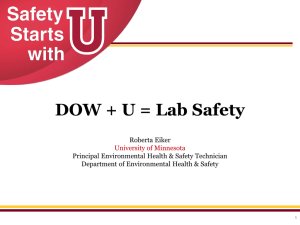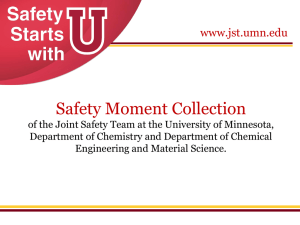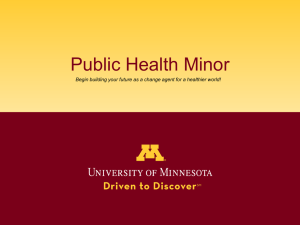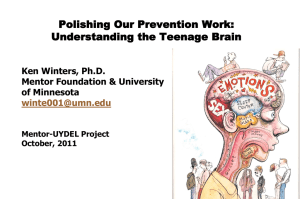Controls and Personal Protective Equipment (PPE) - JST
advertisement
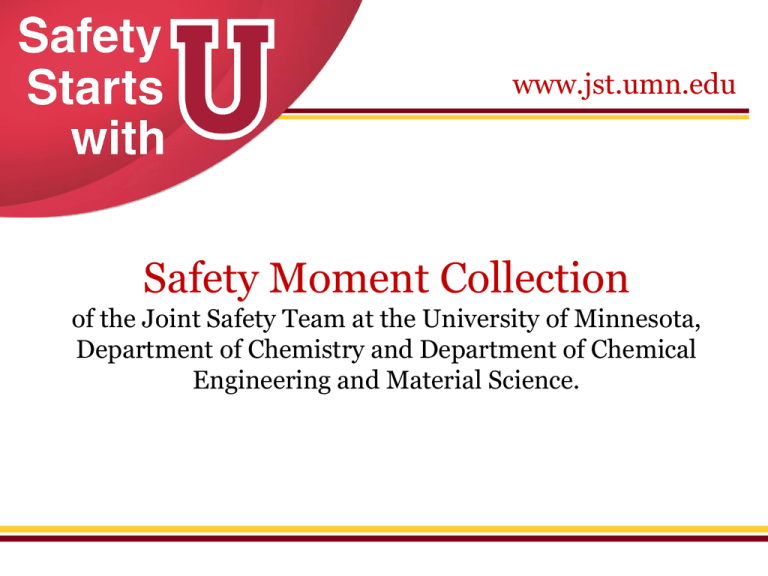
www.jst.umn.edu Safety Moment Collection of the Joint Safety Team at the University of Minnesota, Department of Chemistry and Department of Chemical Engineering and Material Science. www.jst.umn.edu Use these safety moments as you see fit. Feel free to adapt a safety moment to meet the specific needs and time constraints of an audience or occasion; this may mean using only a portion of the prepared slides for a topic or including additional resources for an in-depth discussion. www.jst.umn.edu Have a safety moment? Contribute it to this collection. Send safety moments to jst@umn.edu with Safety Moment <topic> in the subject line. Please put content in the provided template and cite reliable, credited sources. Thank you! Non-PPE Controls www.jst.umn.edu www.jst.umn.edu Hierarchy of Controls More than PPE Eliminate/Minimize Hazards *Using PPE as a primary hazard control is a poor safety practice. www.jst.umn.edu http://www.jst.umn.edu/SOP%20resources.html 6 How to Eliminate/Minimize Hazards How can you eliminate or minimize the identified risks? Standard methods include: 1. Substitution - Use a less hazardous reagent in place of a hazardous one 2. Administrative Control - Modify your procedure or reaction scheme to minimize the risk the hazardous step 3. Personal Protective Equipment* – Use appropriate PPE *A last resort when other methods fail. Using PPE as a primary hazard control is considered a poor safety practice. www.jst.umn.edu http://science.widener.edu/svb/olcc_safety/papers/benedict.pdf 7 www.jst.umn.edu Engineering Controls Redesigning workplaces to reduce hazards Control Systems * Multiple layers to hazard reduction www.jst.umn.edu http://www.jst.umn.edu/SOP%20resources.html l Engineering Controls Include designs or modifications to laboratories, equipment, ventilation systems, and processes that reduce exposure -CCOHS Fume hood Blast shield Emergency override buttons blink.ucsd.edu Workspace design www.labscape.com www.jst.umn.edu www.scrippscollege.edu www.ccohs.ca/oshanswers/hsprograms/hazard_control.html www.controleurope.com Chemical Substitutions To eliminate / minimize hazards Common Substitutions and Evaluating a Potential Substitution Common Chemical Substitutions Instead of : Consider: Benzene Toluene, Cyclohexane, Ketones Carbon tetrachloride 1,1,1- trichloroethane or Isopropyl alcohol Diethyl ether (extractions) Hexanes Chromate ion (oxidation) Hypochlorite ion Formaldehyde (bio preservation) Ethanol or commercial product (ex. Formalternate) Methanol Ethanol, anhydrous Mineral oil Silicon oil K or Na (reactive group 1 metals) Ca or Mg Strong Acid (HCl) / Base (OH-) Acetic acid / bicarbonate Benzoyl peroxide (catalyst) 30% Hydrogen peroxide or Lauroyl Peroxide Chemical Substitution. Health Canada, Environmental and Workplace Health. Accessed 8 Jan 2014. http://www.hc-sc.gc.ca/ewh-semt/occup-travail/whmis-simdut/substitution-eng.php Stroud, L.M. Substitution of a more hazardous chemical by a less hazardous chemical. Science and Safety Consulting Services. Accessed 8 Jan 2014 www.sciencesafetyconsulting.com/pdf/chemical_substitutions.pdf 12 Considering a Potential Substitute Hazards Is the replacement less hazardous ? Read SDS Ensure one hazard is not exchanged for another. Effectiveness Does it meet the process requirements? Is it likely to work? Evaluate & Compare (health, fire, corrosivity, reactivity, etc.) Control Measures Is the new substance adequately controlled by the existing system? (ventilation, vapor pressure, Compatibility Does it interfere or react with other materials or the equipment? temperature, flash point, flammability, etc.) Substitution of Chemicals – Considerations for Selection. Canadian Centre for Occupational Health and Safety. Updated 1 March 2009. Accessed 8 Jan 2013. http://www.ccohs.ca/oshanswers/chemicals/substitution.html 13 More Resources • Transitioning to Safer Chemicals. Occupational Safety and Health Administration. Accessed 8 Jan 2014, https://www.osha.gov/dsg/safer_chemicals/basics.html • IC2 Safer Alternative Assessments. Accessed 8 Jan 2014, http://www.ic2saferalternatives.org/ • Chemical Substitution. Health Canada, Environmental and Workplace Health. Accessed 8 Jan 2014, http://www.hc-sc.gc.ca/ewh-semt/occuptravail/whmis-simdut/substitution-eng.php • Stroud, L.M. Substitution of a more hazardous chemical by a less hazardous chemical. Science and Safety Consulting Services. Accessed 8 Jan 2014, www.sciencesafetyconsulting.com/pdf/chemical_substitutions.pdf 14 Administrative Controls Laboratory policies to minimize hazards Administrative Controls – Written operating procedures (SOPs) – Training requirements • Before working in the lab / General • Specific chemicals or procedures – Lab policies and practices • Working alone / buddy system • Unattended reactions • Housekeeping standards – Limiting time exposure to hazards – Posting signage to identify hazards Building & Room Laboratory Information Principal Investigator, phone/email Lab Safety Officer, phone/email Description Minimum PPE Required Hazards 16 In an emergency, call 911. In non-emergency situations, contact the LSO or PI. Classes of Personal Protective Equipment (PPE) www.jst.umn.edu www.jst.umn.edu Proper Lab Attire Proper Lab Attire • Clothing must cover the arms and legs – Tights/leggings are not appropriate – Short sleeves are okay if lab coat is worn • Loose or draping clothing (i.e. scarves) is unsafe • Long hair should be tied back www.jst.umn.edu 19 Proper Lab Attire • Shoes with traction are preferable • Steel-toed shoes are required when transporting heavy equipment • Socks should cover ankles. X www.jst.umn.edu Prudent Practices in the Laboratory: Handling and Management of Chemical Hazards (2011), Section 6.c.2.6.2 Board on Chemical Sciences and Technology (BCST) 20 NO X Shoes YES √ • Shoes must cover the entire foot • Leather or synthetic leather is best • Thick sole to protect from broken glass Chemical Hygiene Plan, Department of Chemistry. Carleton College. Available at http://apps.carleton.edu/curricular/chem/safety/. Accessed 28 Jan 2013. 21 www.jst.umn.edu Gloves: The basics Best practices for wearing disposable gloves Gloves • Select gloves made of material known to be resistant to permeation by the substances in use. – Lab Safety Supply Company provides chemical compatibility guide for gloves at http://www.labsafety.com/refinfo/ezfacts/EZ166.pdf. • Check gloves (even new ones) tears or pinholes. • Select gloves of the correct size and fit – Too small uncomfortable and may tear – Too large low dexterity • Remove rings and jewelry that can tear gloves www.jst.umn.edu UofM, Department of Environmental Health and Safety. Bio Basics Fact Sheet: Glove Selection and Use Gloves • Replace gloves when – – – – Contaminated Permeated by solvent Torn You have been wearing them awhile • Some gloves, especially lightweight disposables, may be flammable – Keep hands well away from flames or other high temperature heat sources • Consider double gloving, if working with – A highly hazardous compound – Radioactive materials – Situations were there is a high potential for spills or splashes www.jst.umn.edu UofM, Department of Environmental Health and Safety. Bio Basics Fact Sheet: Glove Selection and Use Gloves • Remove gloves before leaving lab area. – Remove in a way that avoids skin contact contaminated glove exterior • Dispose of gloves in non-hazardous (normal) trash – If radioactive chemicals were used, place in radioactive waste. www.hsc.wvu.edu/safety/Laboratory-Safety/Personalprotective-Equipment/Hand-Protection • Wash hands • Do not attempt to re-use disposable gloves. – Increased risk for contamination www.jst.umn.edu UofM, Department of Environmental Health and Safety. Bio Basics Fact Sheet: Glove Selection and Use Gloves • To prevent the unintentional spread of hazardous substances, when wearing gloves don’t touch – Anything used outside the lab • Doorknobs, personal telephones, pens, etc. – Your face or clothes If you are transporting a chemical in the hallway, only wear a glove on one hand. • Have a policy (gloves or no gloves) for lab computer use. – Post your policy on the computer to remind visiting researchers. www.jst.umn.edu UofM, Department of Environmental Health and Safety. Bio Basics Fact Sheet: Glove Selection and Use www.jst.umn.edu Gloves: Chemical Compatibility Glove Comparison Chart Incidental contact: little or no direct contact with the hazardous material. Extended contact: handling highly contaminated materials; submerging hands in a chemical or other hazardous substance; need for physical protection from temperature extremes or www.jst.umn.edu sharp/piercing objects http://www.ehs.berkeley.edu/hs/63-laboratory-safety/94-glove- 28 www.jst.umn.edu 29 www.jst.umn.edu 30 www.jst.umn.edu 31 Water based solution, organic solvents, acids and bases, halogenated hydrocarbons www.jst.umn.edu 32 Glove Usage • • • • • • • • • • • • Wear gloves of a material known to be resistant to permeation by the substances in use. Look for an expiration date on individual packages of gloves. Before use, check gloves (even new ones) for physical damage such as tears or pinholes. Check reusable gloves for previous chemical damage. Dispose of gloves when they show any sign of leakage or deterioration. Select gloves of the correct size and fitting. Some gloves, especially lightweight disposables, may be flammable: keep hands well away from flames or other high temperature heat sources. Replace gloves periodically, depending on the frequency of use and their permeation and degradation characteristics relative to the substances handled. Remove gloves before handling objects such as doorknobs, telephones, pens, and computer keyboards. When removing gloves, do so in a way that avoids skin contact with a possibly contaminated glove exterior. Always wash hands after removing gloves. Dispose of contaminated gloves properly. Do not attempt to re-use disposable gloves. www.jst.umn.edu http://www.dehs.umn.edu/PDFs/gloves.pdf 33 Handling the Heat • OSHA (U.S. Department of Labor Occupational Safety & Health Administration) – Select gloves that provide guarding and insulation Heat resistant gloves (attention: never wet the gloves when you put the autoclaves in water; water is a heat conductor) www.jst.umn.edu 34 Prevention and protection • Read SDS and learn about the temperatures, then select appropriate PPE and employ additional controls Diethyl ether www.jst.umn.edu 35 www.jst.umn.edu Types of eye protection Eye Protection Overview Text Safety Glasses •Impact resistant (shatter proof) and UV shielding lenses •Use when splash potential is low to prevent solvent or object from entering eyes Splash Goggles • Seal around the face and are impact resistant • Use when there is a potential for a splash from a hazardous material • Can wear over prescription glasses Face Shield • Use when working with large volumes of hazardous materials (solvents or particles). • Use in conjunction with safety glasses or goggles. www.jst.umn.edu Boston Medical Center, EHS and Laboratory Safety Committee. July 2011 http://www.bu.edu/orccommittees/files/2011/07/LabSafe-NL_July.pdf Eye Protection Options www.jst.umn.edu http://cenblog.org/the-safety-zone/2010/06/eyes-in-the-lab/ www.jst.umn.edu Googles vs. Safety Glasses Goggles vs. Safety Glasses www.jst.umn.edu Photos courtesy of Michaela Roslawski, Sasha Schrandt, Kei Fuchigami (Photographer) St. Olaf College The Test www.jst.umn.edu Photos courtesy of Michaela Roslawski, Sasha Schrandt, Kei Fuchigami (Photographer) St. Olaf College Goggles www.jst.umn.edu Photos courtesy of Michaela Roslawski, Sasha Schrandt, Kei Fuchigami (Photographer) St. Olaf College The Test www.jst.umn.edu Photos courtesy of Michaela Roslawski, Sasha Schrandt, Kei Fuchigami (Photographer) St. Olaf College Goggles www.jst.umn.edu Photos courtesy of Michaela Roslawski, Sasha Schrandt, Kei Fuchigami (Photographer) St. Olaf College Goggles www.jst.umn.edu Photos courtesy of Michaela Roslawski, Sasha Schrandt, Kei Fuchigami (Photographer) St. Olaf College The Test: Safety Glasses www.jst.umn.edu Photos courtesy of Michaela Roslawski, Sasha Schrandt, Kei Fuchigami (Photographer) St. Olaf College Safety Glasses www.jst.umn.edu Photos courtesy of Michaela Roslawski, Sasha Schrandt, Kei Fuchigami (Photographer) St. Olaf College www.jst.umn.edu Flame Resistant Sleeves A great alternative to a flame resistant lab coat 48 Flame Resistant Sleeves $11.00 per pair vs. ~$100 for a full lab coat Fits over normal lab coat sleeve Protects part of arm most likely to come in contact with flammables while working in the hood http://workingperson.com/national-safety-apparel-16-9oz-fr-green-sateen-sleeve-sewn-inelastic-s02grrg02.html#details 49 Sleeves • Cover your arms • Make sure sleeves don’t inhibit work • Be conscious of longer street clothes sleeves that stick out of a lab coat www.jst.umn.edu http://www.sigmaaldrich.com/labware/safety.html http://onqor.net/ordering/index.php?route=product/product&product_id=57 www.jst.umn.edu Respiratory Protection Is a respirator needed? How can you get one? 51 Respiratory hazards • Aerosolization during common lab procedures – e.g., weighing solids for making solutions – Tris, SDS, Ascorbic acid, MES hydrate. • Harmful/irritating to the eyes and lungs. PPE • Gloves, goggles, lab coat. In general read MSDS before using any chemicals, and possibly respiratory mask. Upon exposure • Eyes : Rinse at the eye shower • Inhalation: Move to fresh air, seek medical aid if experiencing discomfort 52 Respiratory Protection Program • Check the MSDS to determine if a respirator is needed for the chemicals you are working with. • If use of a respirator is required, DEHS will provide you with information to enroll in the University’s Respiratory Protection Program through the Office of Occupational Health • Information on the Respiratory Protection Program can be found at: http://www.ohs.umn.edu/rpp/home.html • Minimum requirements for the program include filling out a health survey and a fit test for the type of respirator you will be using • Additional information is available through the website www.jst.umn.edu http://www.ohs.umn.edu/prod/groups/ahc/@pub/@ahc/@ohs/documents /asset/ahc_asset_108552.pdf www.jst.umn.edu Lab Coat Material Compatibility Splash Protection *All costs estimated from Amazon.com (2014) Less flammable than blends Stock room ~$20 Splash barrier Less susceptible to acids than 100% cotton Polyester/ Cotton Blend 100% Cotton www.jst.umn.edu Lab Coat Information Table. Columbia University EHS, 2008. <http://www.ehs.columbia.edu/ppeLabCoatInformationTable.html>. Laboratory Coat Selection, Use, and Care. MIT EHS, 2013. <https://ehs.mit.edu/site/sites/default/files/files/LabCoatGuidance.pdf>. 55 Flame Resistance *All costs estimated from Amazon.com (2014) ~$40 Less bulky than Nomex® fabric Breathable Flame resistant ~$100 Recommended Launder without for pyrophorics bleach 100% cotton + Flame Retardant (FR) Nomex® www.jst.umn.edu Lab Coat Information Table. Columbia University EHS, 2008. <http://www.ehs.columbia.edu/ppeLabCoatInformationTable.html>. Laboratory Coat Selection, Use, and Care. MIT EHS, 2013. 56 Lab Coat Compatibility Major Hazard Protection Coat Material Cost* Special Benefits Solvent splash Polyester/Cotton Blend ~$20 Better splash and corrosive protection, cheap Solvent splash 100% Cotton ~$20 Lower flammability, cheap 100% Cotton + Flame Retardant (FR) ~$40 Breathable, flame resistant (FR) Nomex IIIA ~$100 Better heat and FR, recommended for pyrophorics Particles contamination, biological fluid, static Microbreathe ~$140 Ideal for clean-room use or static dissipation Non-hazardous mess Polypropylene ~$10 Disposable Fire Fire, pyrophorics www.jst.umn.edu http://www.ehs.columbia.edu/ppeLabCoatInformationTable.html https://ehs.mit.edu/site/sites/default/files/files/LabCoatGuidance.pdf *On Amazon.com 57 www.jst.umn.edu Acid Aprons Acid Aprons Nitrile blend aprons are resistant to acid and base They should be used when working with concentrated acid or base, especially when in large amounts Aprons are available in the stockroom Don’t forget your goggles and acid resistant gloves! www.jst.umn.edu 59 PPE Protocol www.jst.umn.edu www.jst.umn.edu Personal Protective Equipment Where – and where not – to wear it! Wear PPE when: Working in laboratory spaces When using a “gloves on” keyboard Lab coat is okay to wear when walking from lab to lab, unless is it known to be contaminated with a particularly hazardous substance. www.jst.umn.edu When NOT to wear PPE Outside Bathrooms Offices/ non-lab spaces When using mobile phones www.jst.umn.edu When using a “gloves off” keyboard When NOT to wear PPE When quenching your thirst. Don’t risk ingesting chemicals and spreading them to drink containers. Is a beverage container only touched with gloves on? Note: Labs where hazardous chemicals are used have 6 - 12 air changes per hour. Increased thirst www.jst.umn.edu 64 Transporting Chemicals • Use secondary containment (bucket) • One gloved hand, one ungloved hand • Carry other needed PPE if moving between labs www.jst.umn.edu www.jst.umn.edu PPE and Chemical Packages 66 Opening Chemical Packages • PPE required to transport chemicals within and between labs • Best practice suggests PPE should be worn when opening packages containing chemicals – Packaging is form of engineering control – PPE protects in case that control fails www.jst.umn.edu 67 www.jst.umn.edu Lab Coat Laundering System Importance of a Clean Lab Coat • Wearing a seriously soiled lab coat is like wearing hazardous waste! • Chemistry department now offers a FREE lab coat laundering service • Monthly service www.jst.umn.edu 69 How it works Every 4th Wednesday • Drop off dirty lab coats to Smith S18 • Make sure your name is written on the pocket (not collar) • There will be two hampers: – Coats that DO have the vendor’s barcode in the collar – Coats that DO NOT have the vendor’s barcode in the collar. • Look for a monthly email reminder Thursday afternoon, 4 weeks later • Pick up your clean lab coat from Smith S18 www.jst.umn.edu Available Resources www.jst.umn.edu DEHS Contact Anna Sitek (Englund) E-mail: engl0131@umn.edu Phone: (612) 625-8925 Office W-147 Boynton Research Safety Specialist assigned to our department, and newly-created DEHS safety contact for our entire college. She will serve as a member of our department Safety Committee and will work with the JST. Feel free to contact her with any questions! www.jst.umn.edu JST website www.jst.umn.edu www.jst.umn.edu Dow Safety Academy http://safety.dow.com/ www.jst.umn.edu www.jst.umn.edu 7 www.jst.umn.edu Have a safety moment? Contribute it to this collection. Send safety moments to jst@umn.edu with Safety Moment <topic> in the subject line. Please put content in the provided template and cite reliable, credited sources. Thank you! www.jst.umn.edu www.jst.umn.edu Templates www.jst.umn.edu www.jst.umn.edu Safety Moment Title www.jst.umn.edu 80 www.jst.umn.edu www.jst.umn.edu
